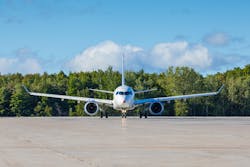OEMs Leverage Technologies to Lower Airline Operating Cost
Technology is providing airlines significant savings in maintenance as the next generation single-aisle airplanes begin revenue service operation. Airplane and engine OEMs have leveraged advances in materials, part designs, and electronic monitoring systems to improve fuel efficiency and reliability while extending service intervals to lower overall operating cost. Both Airbus and Boeing have established record-setting backlogs as airlines upgrade their fleets with their next generation models to take advantage of the lower fuel consumption and greater maintenance efficiencies.
Airplane manufacturers have leveraged advanced technology to extend maintenance intervals by as much as 40 percent. Today’s single aisle airplanes require A check and C check maintenance be performed at 600 hours and 6,000 hours, respectively. The airplane OEMs have made improvements to their new models extending service intervals and lowering maintenance requirements.
Extended Inspection Intervals
Landing gear components on both the Airbus A320neo and Boeing 737MAX models have been upgraded as a result of the larger, heavier engines on these new airplanes. As a result, both airplane manufacturers are extending inspection intervals and lowering maintenance requirements. For an example, Safran Landing Systems’ new carbon brake system on the A320neo incorporates improved designs giving it higher performance while improving reliability at lower maintenance cost. The brake system has fewer pistons and more carbon to improve operational efficiency and lower maintenance. The braking system ventilation is reported to have been increased 48 percent to improve cooling and dispatch reliability. Airbus has announced that it is working to extend major airframe checks on the neo models with many of the A and C Check maintenance procedures being extended to 750 hours and 7,500 hours, respectively.
Boeing has upgraded the data recording and monitoring capabilities of the 737MAX by providing an onboard network system. This system improves the recording of key data and integrates this data with troubleshooting onto a single system. The improved monitoring system includes onboard tire pressure and brake temperature. The onboard network file server performs many of the aircraft’s self-diagnostics providing a more comprehensive overview of the aircraft’s components. This system increases data availability and communication for the airline’s ground personnel improving maintenance efficiency.
The Bombardier CSeries models have increased A check and C check intervals to 850 hours and 8,500 hours, respectively, enabling airlines to extend service intervals and lower operating cost. There are only seven maintenance tasks under 850 flight hours. These tasks can be completed during routine overnight activities. The advanced health monitoring system of the CSeries integrates airplane and engine monitoring systems providing line maintenance personnel the ability to quickly service and troubleshoot problems to minimize flight disruptions. The CSeries monitoring system reports the status of 34 main systems with approximately 5,000 parameters allowing maintenance personnel to review and service the airplane quickly. Over 70 percent of the line replaceable units, LRUs, can be replaced within 15 minutes. The monitoring of these LRUs and other aircraft systems will significantly improve the airline’s maintenance capability thus improving dispatch reliability and operational efficiency.
New Fuel-Efficient Engines
The combination of these airplane systems advancements with the new engine designs of Pratt & Whitney’s Geared Turbofan Engine®, the PW1000G, and CFMI’s LEAP models significantly lower airline operational cost by improving fuel efficiency, lowering airport fees associated with noise and emissions, and reducing maintenance and repair cost. Both engine OEMs have enhanced their engine electronic controls to improve reliability. The engine manufacturers have expanded data monitoring including the ability to validate and synthesize engine measurements should a measurement sensor fail. These new powerplants have up to 40 percent more sensors enabling a significant increase in parameter recording. Enhanced troubleshooting with the addition of prognostic capabilities improves fault detection and engine maintenance action effectiveness. Airlines are using this monitoring capability to optimize maintenance programs including performing preventative maintenance to improve dispatch reliability.
Other engine design features to improve maintainability include improved inspection and expanded on-wing repair capabilities, improved resistance to foreign object damage (FOD), and optimized designs for the line replaceable units (LRUs). As an example, the designs of the fuel and oil systems as well as electrical harnesses have been optimized for maintainability. LRUs are more accessible allowing removal and replacement under 30 minutes.
What do these OEM technologies provide to the airlines in terms of savings? For the typical 150- to 200-passenger jet operating in North America, fuel cost represents ~35 percent of the airline’s operating cost while maintenance represents ~15 percent. These next generation products lower fuel consumption 10 to 16 percent and offer double digit savings in maintenance cost. These savings can represent as much as $1M USD per airplane per year for a typical operator.
Is there more to come? OEMs are providing comprehensive support to the airline leveraging their product design knowledge and engineering expertise to develop improved repairs and maintenance procedures. Leveraging the use of “big data” and other leading-edge tools to better understand operational characteristics will allow the OEMs to improve reliability and tailor maintenance procedures for regional influences and specific operator utilization rates. They continue to invest in advanced technologies with the goal of lowering cost of ownership while being a good steward of the environment and improving flight safety.
About the Author

Robert Saia
Robert (Bob) Saia began a consulting company after retiring from Pratt & Whitney Aircraft in June 2014. Bob’s last position at P&W was VP, Commercial Engine Development Programs. Bob led an interdisciplinary team that developed and brought to market the company's next generation of commercial engines, the Pratt & Whitney PurePower® PW1000G engine with Geared TurboFanTM technology. Bob began his career with Pratt & Whitney in Engineering and later moved into Business and Program positions. Bob’s consulting company specializes in providing technical services, strategic business development and marketing services. He can be reached at [email protected] or (860) 874-9323.
